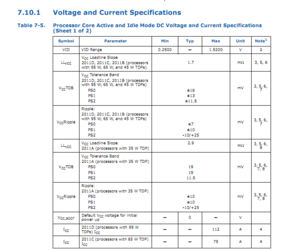What determines the ceiling of voltage I should pump into this chip for an OC - 24/7 safe use for gaming.
Is it strictly a temp thing? Currently, 4.7ghz at 1.45 volts (need to make this more precise, could maybe drop .05-.1 volts) on p95 blend tests - max temp of around 58 C in an ~ 70 F ambient room.
Water cooled (cpu only)
Furthermore, if I can achieve this speed only touching vcore, is there any reason I need to mess with LLC / PLL / over voltage stuff?
EDIT - Furthermore, I can get a much lower vcore setting with load line calibration at 6 (1-10 settings) but I have read differing views on this setting. Is it again a temp thing? Is the excess voltage at idle that bad if temps are low? I would imagine putting it all the way to 10, or even high at 7/8 would net me even better results. Opinions?
Also, PLL overvoltage doesnt have an on off. It has auto, + or -5% and +10%. Mainly worried how much is too much here and really above !
Is it strictly a temp thing? Currently, 4.7ghz at 1.45 volts (need to make this more precise, could maybe drop .05-.1 volts) on p95 blend tests - max temp of around 58 C in an ~ 70 F ambient room.
Water cooled (cpu only)
Furthermore, if I can achieve this speed only touching vcore, is there any reason I need to mess with LLC / PLL / over voltage stuff?
EDIT - Furthermore, I can get a much lower vcore setting with load line calibration at 6 (1-10 settings) but I have read differing views on this setting. Is it again a temp thing? Is the excess voltage at idle that bad if temps are low? I would imagine putting it all the way to 10, or even high at 7/8 would net me even better results. Opinions?
Also, PLL overvoltage doesnt have an on off. It has auto, + or -5% and +10%. Mainly worried how much is too much here and really above !
Last edited:


